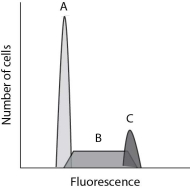After reading the paragraphs below, answer the questions that follow.
A technique called flow cytometry is used by scientists and researchers to count or sort cells based on specific properties. By labeling cellular DNA with a fluorescent dye, flow cytometry can sort cells based on the amount of DNA present, thereby making it possible to distinguish between cells that are in different stages of the cell cycle. Flow cytometry is especially useful to the medical community because it can help with the diagnosis of certain types of cancers.
Below is a typical set of data that you might obtain when running a flow cytometry experiment using a sample of healthy skin cells. Use this figure to help you answer the following questions.

-Which peak corresponds to cells in G₁? In S phase? In G₂?
Definitions:
Circadian Rhythm Disorder
A disruption in the natural circadian rhythm, the internal clock that regulates sleep-wake cycles, leading to sleep disturbances and other health issues.
Rotating Shifts
A work schedule that changes over a period of days or weeks, involving varying shift times such as mornings, afternoons, and nights.
Sleepwalking
A behavior disorder that involves walking or performing other complex behaviors while in a state of deep sleep.
Non-Rapid Eye Movement
A phase of sleep characterized by slower brain waves, reduced eye movement, and decreased body movement, which includes stages 1 through 3 of the sleep cycle.
Q5: Which of the following statements regarding glycolysis
Q16: Transcription factors attach to<br>A)DNA.<br>B)signal molecules.<br>C)plasma membrane receptors.<br>D)mRNA.
Q19: A man with a dirty cut on
Q19: Which of the following options lists the
Q28: Sunlight is a type of _ energy.<br>A)electromagnetic<br>B)chemical<br>C)mechanical<br>D)sound
Q31: In many grocery stores, fresh fruits are
Q34: The signal that crosses a synapse is
Q50: Which of the following occurs when RNA
Q63: If you used flow cytometry to sort
Q67: How many sex chromosomes are in a